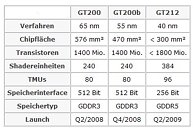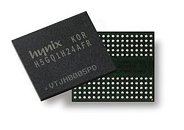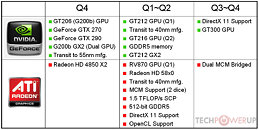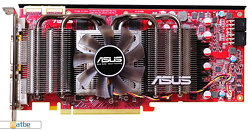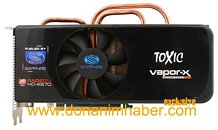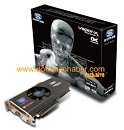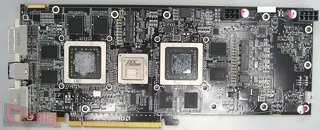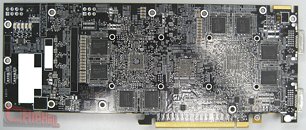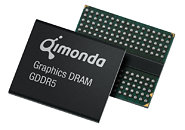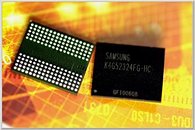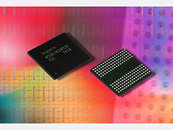Mar 29th, 2025 07:56 EDT
change timezone
Latest GPU Drivers
New Forum Posts
- Small chip on the tempered glass (1)
- Upgrade from a AMD AM3+ to AM4 or AM5 chipset MB running W10? (19)
- Future-proofing my OLED (57)
- Windows 10 Vs 11, Which one too choose? (118)
- What are you playing? (23306)
- RTX 5080 - performance fluctuation (6)
- Did Nvidia purposely gimp the performance of 50xx series cards with drivers (114)
- AMD RX 9070 XT & RX 9070 non-XT thread (OC, undervolt, benchmarks, ...) (71)
- TPU's F@H Team (20414)
- Have you got pie today? (16650)
Popular Reviews
- Sapphire Radeon RX 9070 XT Pulse Review
- Samsung 9100 Pro 2 TB Review - The Best Gen 5 SSD
- ASRock Phantom Gaming B850 Riptide Wi-Fi Review - Amazing Price/Performance
- Assassin's Creed Shadows Performance Benchmark Review - 30 GPUs Compared
- be quiet! Pure Rock Pro 3 Black Review
- Sapphire Radeon RX 9070 XT Nitro+ Review - Beating NVIDIA
- ASRock Radeon RX 9070 XT Taichi OC Review - Excellent Cooling
- Palit GeForce RTX 5070 GamingPro OC Review
- Pulsar Feinmann F01 Review
- AMD Ryzen 7 9800X3D Review - The Best Gaming Processor
Controversial News Posts
- AMD RDNA 4 and Radeon RX 9070 Series Unveiled: $549 & $599 (260)
- MSI Doesn't Plan Radeon RX 9000 Series GPUs, Skips AMD RDNA 4 Generation Entirely (142)
- Microsoft Introduces Copilot for Gaming (124)
- AMD Radeon RX 9070 XT Reportedly Outperforms RTX 5080 Through Undervolting (118)
- NVIDIA Reportedly Prepares GeForce RTX 5060 and RTX 5060 Ti Unveil Tomorrow (115)
- Over 200,000 Sold Radeon RX 9070 and RX 9070 XT GPUs? AMD Says No Number was Given (100)
- NVIDIA GeForce RTX 5050, RTX 5060, and RTX 5060 Ti Specifications Leak (96)
- Retailers Anticipate Increased Radeon RX 9070 Series Prices, After Initial Shipments of "MSRP" Models (90)
News Posts matching #GDDR5
Return to Keyword Browsing
More GT212 Information Forthcoming
NVIDIA's G200b, its current flagship GPU will be suceeded later this year with the GT212, and as Hardware Infos discovers, NVIDIA seems to have given some interesting specifications to the GT212. To begin with, the GPU holds more than 1.8 billion transistors. It is built on TSMC's 40nm manufacturing node. The shader domain gets a boost with 384 shader units (a 60% increase over G200(b)). The GPU holds 96 texture memory units and a 256-bit wide GDDR5 memory bus with a clock speed of 1250 MHz (5000 MT/s).
The transition to GDDR5 seemed inevitable, with there being a genuine incentive of cutting down the number of memory chips (due to the efficient memory bus), with NVIDIA having completely avoided GDDR4. With the die-size being expected to be around 300 sq. mm, these GPUs will be cheaper to manufacture. The GT212 is slated for Q2 2009.
The transition to GDDR5 seemed inevitable, with there being a genuine incentive of cutting down the number of memory chips (due to the efficient memory bus), with NVIDIA having completely avoided GDDR4. With the die-size being expected to be around 300 sq. mm, these GPUs will be cheaper to manufacture. The GT212 is slated for Q2 2009.
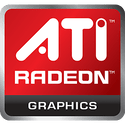
RV740 Successfully Taped Out, Other 40nm GPUs Follow
The RV740 graphics processor by AMD could well be the first GPU in production, to be built on the newer 40nm manufacturing process, giving its makers something to brag about. The RV740 design and specifications are largely derived from the RV770LE (covered here), while bringing the GDDR5 memory standard to the mainstream.
Chinese industrial journals tell DigiTimes that the company has completed taping-out the RV740, and that the GPU is awaiting mass-production by AMD's foundry partner, Taiwan Semiconductor Manufacturing Company (TSMC). Mass production of products based on this GPU could commence by the end of Q1 2009.
Chinese industrial journals tell DigiTimes that the company has completed taping-out the RV740, and that the GPU is awaiting mass-production by AMD's foundry partner, Taiwan Semiconductor Manufacturing Company (TSMC). Mass production of products based on this GPU could commence by the end of Q1 2009.

RV740 a 40nm RV770LE in Disguise?
RV740, the first GPU built by AMD on the 40nm silicon fabrication process, seems to be gaining attention. While earlier reports suggested this core to be simply a miniaturized RV730, a fresh report emerging from VR-Zone says otherwise.
The RV740 is supposed to be largely derived from the RV770, as in its RV770LE avatar which went into making the ATI Radeon HD 4830. There are some interesting specifications attached to it. To begin with, the core physically holds only 640 stream processors, in comparison to the 800(+) on the RV770. The core continues to have 32 texture memory units (TMUs) and 16 render back-ends. Interestingly, there is a 128-bit wide GDDR5 memory bus instead of 256-bit wide GDDR3 (for the RV770LE). With this, the RV740 has a rated memory bandwidth identical to that of the RV770LE, 57.6 GB/s, though the bus width would warrant the use of lesser number of memory chips, and effectively reduce manufacturing costs. Graphics cards based on this GPU are expected to emerge in early 2009. You can also expect derivatives based on this core with GDDR4, GDDR3 or even DDR2 memory. In any case, the products are expected to cost below US $100.
The RV740 is supposed to be largely derived from the RV770, as in its RV770LE avatar which went into making the ATI Radeon HD 4830. There are some interesting specifications attached to it. To begin with, the core physically holds only 640 stream processors, in comparison to the 800(+) on the RV770. The core continues to have 32 texture memory units (TMUs) and 16 render back-ends. Interestingly, there is a 128-bit wide GDDR5 memory bus instead of 256-bit wide GDDR3 (for the RV770LE). With this, the RV740 has a rated memory bandwidth identical to that of the RV770LE, 57.6 GB/s, though the bus width would warrant the use of lesser number of memory chips, and effectively reduce manufacturing costs. Graphics cards based on this GPU are expected to emerge in early 2009. You can also expect derivatives based on this core with GDDR4, GDDR3 or even DDR2 memory. In any case, the products are expected to cost below US $100.
Hynix 7GT/s GDDR5 Chip to Make it to Major SKUs, R700 Included
Sources in the industry point out that the 7 GT/s GDDR5 memory chip made by Hynix (model: H5GQ1H24AFR), which was announced earlier in this week, would make it to several major graphics board SKUs by both AMD and NVIDIA. The two companies have chosen TSMC and its 40nm fabrication process as the foundry partner for their upcoming 40nm graphics processors, namely AMD RV870 and NVIDIA GT212.
Both these chips would feature GDDR5 memory bus capabilities, and there are indications of the 7 GT/s DRAM chip being incorporated into graphics boards based on these GPUs. Additionally, there is also word that AMD will be using the said DRAM chip in its current flagship graphics card, the Radeon HD 4870 X2 in the near future. Both AMD and NVIDIA are expected to have taped out their 40nm GPU designs within Q1, 2009.
Both these chips would feature GDDR5 memory bus capabilities, and there are indications of the 7 GT/s DRAM chip being incorporated into graphics boards based on these GPUs. Additionally, there is also word that AMD will be using the said DRAM chip in its current flagship graphics card, the Radeon HD 4870 X2 in the near future. Both AMD and NVIDIA are expected to have taped out their 40nm GPU designs within Q1, 2009.
Hynix Rolls-out 7 GT/s GDDR5 Memory Chip
DRAM major, Hynix has announced the depelopment of 7 GT/s GDDR5 memory chips for use by the visual-computing industry. These chips are built on the company's 54nm silicon fabrication technology.
The 1 Gb (128 MB) chips labelled H5GQ1H24AFR operate at the fastest speeds so far: 7 Gbps (or GT/s), which is a 40% boost in speeds compared to the older 5 GT/s chips already in production. The chip handles up to 28 GB of data per second across a 32-bit wide interface. The incorporation of new fab. processes also means reduced power consumption at 1.35V power supply. The JEDEC-standard 1Gb GDDR5 graphics DRAM chip targets high-end applications such as game consoles and graphics cards. The company will commence volume production in the first half of 2009.
The 1 Gb (128 MB) chips labelled H5GQ1H24AFR operate at the fastest speeds so far: 7 Gbps (or GT/s), which is a 40% boost in speeds compared to the older 5 GT/s chips already in production. The chip handles up to 28 GB of data per second across a 32-bit wide interface. The incorporation of new fab. processes also means reduced power consumption at 1.35V power supply. The JEDEC-standard 1Gb GDDR5 graphics DRAM chip targets high-end applications such as game consoles and graphics cards. The company will commence volume production in the first half of 2009.

Power and Innovation to Drive High-End GPUs in 2009
The year 2008 so far, has been very eventful for the graphics card market. A reinvigorated GPU lineup by ATI, brought in some fierce competition to NVIDIA, which resulted in a tug-of-war with pricing graphics cards in the market, with either company refusing to lose on grounds of pricing. This event, coupled with the announcement of several game titles by game publishers, resulted in bumper-sales of graphics cards, giving the present state of the global economy little or no relevance.
The months to come hold the same amount of importance for both AMD and NVIDIA, where the next round of competition begins with successors to current high-end products being slated. NVIDIA is expected to continue with its monolithic high transistor-count GPU design methodology, while AMD could bring in a little change to the way it uses two efficient GPUs to build powerful products.
The months to come hold the same amount of importance for both AMD and NVIDIA, where the next round of competition begins with successors to current high-end products being slated. NVIDIA is expected to continue with its monolithic high transistor-count GPU design methodology, while AMD could bring in a little change to the way it uses two efficient GPUs to build powerful products.

ASUS Prepares Dark Knight ATI Radeon HD 4870 512MB GDDR5 Video Card
French site Matbe, posted today photos of the first ATI video card produced by ASUS and branded as Dark Knight edition. This is the third card (correct me if I'm wrong) to go under this relatively new series of ASUS video cards. The EAH4870 DK/HTDI/512M is an ATI Radeon HD 4870 with 512MB GDDR5 memory, a PCI-Express 2.0 interface CrossFireX support and dual-DVI connectivity. Although the Dark Knight nickname suggests boosted clock speeds the card comes at the reference 750MHz GPU and 3600MHz memory speeds. It only features an improved cooling system, that consists of four heatpipes and bigger fan. Early European etailers already price the card at 263 Euro. A Dark Knight HD 4870 with 1GB onboard memory is also rumored to be in the works.

Sapphire Radeon HD 4870 TOXIC 512MB GDDR5 Video Card Spotted
AMD/ATI's graphics partner Sapphire has released today Radeon HD 4870 TOXIC, an overclocked Radeon HD 4870 card with a custom cooling on it. What makes this card so special is the patented Vapor-X cooling system and its clock speeds higher than the reference boards. The cooling itself takes up two slots, makes use of a Vapour Chamber technology and features a thermally-controlled fan supported by three copper heatpipes. The new TOXIC model is also factory-overclocked to 780MHz GPU from 750MHz stock speed and 4000MHz memory from 3600MHz stock respectively. The card is equipped with 512MB GDDR5 memory. It offers 800 Stream Processors, has DirectX 10.1 and CrossFireX support, a PCI-Express 2.0 interface and two DVI connectors. Except that and maybe the fancy retail box it ships with, there's nothing else about this card that could interest you more. Pricing and availability are still unknown.

MSI Unveils its R4870-T2D1G Graphics Cards With 1 GB GDDR5 Memory
MSI, a leading manufacturer of computer products, proudly unveils its latest R4870-T2D1G graphics cards for the game enthusiasts. It comes with the 1G DDR5 memory which enables users to enjoy the DirectX 10 high-capacity 3D games easily and smoothly.
This high-end level graphics card is based on the latest 2nd generation of 55nm GPU. Integrated with the ATI PowerPlay power-saving technology, MSI R4870-T2D1G provides twice the performance enhancement with the same wattage. It conforms to the environmental energy conservation worldwide initiative with MSI (ECOlution) environmental protection theory of evolution objective. In addition, MSI R4870-T2D1G graphics card also has the advanced UVD 2.0 video decoder core, a built-in HDCP key encryption which supports Blu-Ray and HD DVD movie disc playback and make 100% complete hardware acceleration to the MPEG-2/VC-1/H.264 video format. MSI R4870-T2D512 supports the DirectX 10.1 framework of Windows Vista Service Pack 1 and offers 800 stream processors, which achieve the unprecedented levels teraflop (1000Gflops) computing capability. MSI R4870-T2D1G graphics card supports CrossFireX technology. Combined with CrossFire ready mainboard to enable 2~4 graphics cards to work at the same time; substantially enhancing gaming performance.
This high-end level graphics card is based on the latest 2nd generation of 55nm GPU. Integrated with the ATI PowerPlay power-saving technology, MSI R4870-T2D1G provides twice the performance enhancement with the same wattage. It conforms to the environmental energy conservation worldwide initiative with MSI (ECOlution) environmental protection theory of evolution objective. In addition, MSI R4870-T2D1G graphics card also has the advanced UVD 2.0 video decoder core, a built-in HDCP key encryption which supports Blu-Ray and HD DVD movie disc playback and make 100% complete hardware acceleration to the MPEG-2/VC-1/H.264 video format. MSI R4870-T2D512 supports the DirectX 10.1 framework of Windows Vista Service Pack 1 and offers 800 stream processors, which achieve the unprecedented levels teraflop (1000Gflops) computing capability. MSI R4870-T2D1G graphics card supports CrossFireX technology. Combined with CrossFire ready mainboard to enable 2~4 graphics cards to work at the same time; substantially enhancing gaming performance.

PowerColor Radeon HD 4870 PCS OC Emerges
PowerColor is preparing an overclocked Radeon HD4870, the PCS (Professional Cooling System) model. This model uses 1 GB of GDDR5 memory and uses overclocked parameters, such as 800 MHz core. This card comes with a cooler made by Zerotherm comprising of heatpipes conducting to aluminum fins on either sides of a fan. According to TG Daily, this card could be based on the SuperRV770 concept, where high-performing parts are used along with 1 GB of GDDR5 memory. According to PowerColor, this cooler could keep the temperatures down by up to 20° C versus reference ATI cooler even at the overclocked 800 MHz core setting.

R700 up to 80 % Faster than GeForce GTX 280
Pre-release performance evaluations suggest that the Radeon HD 4870 X2 2GB GDDR5 model will on an average be 50% faster than the GeForce GTX 280 and in some tests 80% faster. A second model, the HD 4850 X2 (2GB GDDR3 memory, 2x RV770Pro) will also convincingly outperform the GeForce GTX 280. The R700 series will be brought into the market late-July thru August.

NVIDIA Plans to Nuke R700
NVIDIA Plans to Nuke R700?
Let's face it, the ATI RV770 and its derivatives have become a rage. Everybody loves this chip and wants a card based on this, be it the card that made NVIDIA slash their prices, the HD4850 or the HD4870 which rivals the GeForce GTX 260 at a decent price. In surveys conducted by several websites, be it TweakTown or Hexus.net, majority community members chose ATI as a brand over NVIDIA, rougly indicating that the HD4000 series has done an excellent repair job with ATI and its brand value.
Nothing (exciting) is going NVIDIA's way these days, their notebook graphics division has taken a beating over the recent faulty parts issue. The NVDA stock is a little volatile at the stock market these days, after the company announced it predicts weaker earnings this quarter financial year. Here's something to ponder: If NVIDIA predicts weaker earnings, how come talks are they have something to counter the R700, which AMD already made statements about, saying it will "overwhelm the GeForce GTX 280"?
Let's face it, the ATI RV770 and its derivatives have become a rage. Everybody loves this chip and wants a card based on this, be it the card that made NVIDIA slash their prices, the HD4850 or the HD4870 which rivals the GeForce GTX 260 at a decent price. In surveys conducted by several websites, be it TweakTown or Hexus.net, majority community members chose ATI as a brand over NVIDIA, rougly indicating that the HD4000 series has done an excellent repair job with ATI and its brand value.
Nothing (exciting) is going NVIDIA's way these days, their notebook graphics division has taken a beating over the recent faulty parts issue. The NVDA stock is a little volatile at the stock market these days, after the company announced it predicts weaker earnings this quarter financial year. Here's something to ponder: If NVIDIA predicts weaker earnings, how come talks are they have something to counter the R700, which AMD already made statements about, saying it will "overwhelm the GeForce GTX 280"?

R700 to Come in 2048MB Flavour?
Although unreliable sources have been pointing out to the possibility that The Radeon HD 4870 X2 (R700) could come in a 2GB variant for a while now, we now get reports from even the Taiwanese industry observer, DigiTimes that the R700 in fact could come in a 2048 MB GDDR5 flavour. Similar reports have also been sourced from the likes of HKEPC and ChipHell. Current products such as the Radeon HD 4870 come equipped with "IDGV51-05A1F1C-40X" 512 Mbit GDDR5 chips made by Qimonda, the cards feature 8 such chips. It's already known that the R700 comes with a total of 16 memory chips, 8 on each side of the PCB, Qimonda readies its 1 Gbit memory chips slated for a July, 2008 release, Hyundai/Hynix already have their parts in the making.
Expect this product to launch by late August.With inputs from DigiTimes
Expect this product to launch by late August.With inputs from DigiTimes

NVIDIA Roadmap Suggests DirectX 10.1 GPU in Q4 2008, GDDR5 in 2008
TG Daily stumbled across roadmap information of NVIDIA which provides certain details of the green giant's DirectX 10.1 implementation plans. Currently, ATI and S3 Graphics make graphics processors (GPU) compliant to DirectX 10.1 specifications. In a presentation slide, are seen plans of NVIDIA coming up with a brand new fleet of mobile (notebook) DirectX 10.1 graphics processors slated for spring 2009 and desktop GPUs either for late Q4 2008 or early 2009 with a possible ramp throughout Q1 and Q2 of 2009.
This gives competitors at least a 6-month time advantage in which they could build developer relations and aid development of games based on the DirectX 10.1 API since it's now certain that the API is going to become an industry-wide standard, with the biggest player in the discrete-graphics industry having plans to embrace it.
The second revelation that slide brings up is that NVIDIA will implement GDDR5 memory with its upcoming products within 2008.
This gives competitors at least a 6-month time advantage in which they could build developer relations and aid development of games based on the DirectX 10.1 API since it's now certain that the API is going to become an industry-wide standard, with the biggest player in the discrete-graphics industry having plans to embrace it.
The second revelation that slide brings up is that NVIDIA will implement GDDR5 memory with its upcoming products within 2008.

ATI Radeon HD 4870 X2 1GB GDDR5 Nude Shots
I spotted some new nude shots of the upcoming ATI Radeon HD 4870 X2 graphics card today and decided to share them with you. Little is known about the card's specs at the time, but what's apparent from the pics is the black PCB, the two 55nm-built RV770 GPUs and the PLX PCI-Express 2.0 bridge chip situated between the GPUs. On both sides of the PCB there are 16 Qimonda GDDR5 chips for a total of 1GB video memory. Also one 6-pin and one 8-pin PCI-E connectors will be needed for proper operation.
Qimonda Wins AMD as Partner for Launch of New Graphics Standard GDDR5
Qimonda AG, a leading manufacturer of memory products, today announced that the company has won AMD as launch partner for the new graphics standard GDDR5. Qimonda already started mass production and the volume shipping of GDDR5 512Mbit components with a speed of 4.0Gbps to AMD, a leading global provider of innovative processing solutions in the computing, graphics and consumer electronics markets.
Qimonda Ready with GDDR5 Memory Chips
Qimonda first began sampling 512Mb GDDR5 memory chips in November 2007 and now, six months after, the memory manufacturer claims to have the parts ready to roll. "Qimonda was the first to announce samples of GDDR5 back in November 2007. We have proven the technology and we can deliver in volume production to the market today," said Glen Haley, communications director of Qimonda in North America, in an interview with X-bit labs web-site. Currently Qimonda has GDDR5 parts that will run at 3.60GHz, 4.0GHz and 4.50GHz clock-speeds and use PG-TFBGA-170 packages. They will boast the maximum available data transfer rate up to 20GB/s, as compared to 16GB/s for the previous GDDR4 generation. GDDR5 chips are also projected to play a substantial role in the next round of war between leading graphics manufacturers. Reports claim that the latest AMD/ATI 4-series Radeon video cards will make use of GDDR5. Hynix Semiconductor and Samsung Electronics are also expected to make available their own GDDR5 memory chips soon.
Report: GDDR Price About to Rise
DigiTimes today reported that prices of DRAM parts may rise, citing sources at Taiwan IC distributors.
Some DRAM makers have started allotting more capacity for commodity DRAM, especially SO-DIMMs for notebooks, the sources said. Capacity for GDDR has started to strain amid the strategic capacity allocation, they noted. As DRAM makers are expected to reserve capacity priority for commodity DRAM for 1-2 quarters, a price revision for GDDR is thus likely, they said. The sources indicated that a price hike is likely to be seen from the second half of May, as some system makers are expected to completely digest their inventory by then.Let's hope this won't give occasion for ATI and NVIDIA for just another delay or price bump. Both companies are set to launch their next-generation graphics cards over the coming months. The latest ATI Radeon HD 4 series cards will use both GDDR3 and GDDR5 memory parts.

Samsung Develops GDDR5 Memory at 6Gbps
Samsung Electronics has announced that it has developed the world's fastest memory, a GDDR5 (series five, graphics double-data-rate memory) chip that can transfer data at six gigabits per second (Gbps). Samsung's GDDR5, which will be introduced at a density of 512 Mb (16Mb x 32) chips, is capable of transmitting moving images and associated data at 24 gigabytes per second (GBps). The new Samsung graphics memory operates at 1.5 volts, representing an approximate 20% improvement in power consumption over today's most popular graphics chip, the GDDR3. Samples of Samsung's new GDDR5 chip have been delivered to major graphic processor companies last month and mass production is expected in the first half of 2008. Samsung expects that GDDR5 memory chips will become standard in the top performing segment of the market by capturing more than 50% of the high-end PC graphics market by 2010.
Hynix Introduces Industry's First 1Gb GDDR5 DRAM
Hynix Semiconductor today introduced the industry's first 1 Gigabit GDDR5 Graphics DRAM. The industry's first 1Gb GDDR5 from Hynix is also the fastest and highest density graphics memory available. It operates at 5Gbps bandwidth and processes up to 20 Gigabytes of data per second with a 32-bit I/O, ideal in applications with high definition video and cinematic and photo-realistic graphics content. A bandwidth of 20 Gigabytes per second offered by the Hynix 1Gb GDDR5 can process more than 20 hours of DVD quality video.
Qimonda Samples GDDR5
Memory manufacturer Qimonda claims to have started producing the worlds first 512MB GDDR5 chips. Like past GDDR revisions, GDDR5 increases the maximum bandwidth between a graphics processor and the graphics memory. GDDR5 boasts a whopping 20GB/s bandwidth, up from the GDDR4 bandwidth of 16GB/s. Qimonda claims that GDDR5 improves power consumption by downclocking unused VRAM. Qimonda will release their GDDR5 RAM "sometime in 2008". You can read the full Qimonda GDDR5 briefing here.

Samsung Announces Intel Certified 50nm-class DDR2 DRAM
Samsung Electronics announced the availability of its new 50nm-class DDR2 DRAM certified by Intel. Samsung technicians state that processing 1Gb DDR2 DRAMs in the 50nm range doubles productivity and improves the production efficiency by 50% in comparison to a 1Gb DDR2 DRAM fabricated using 80nm process technology. Samsung's 50nm-class DRAM processing technology will be used not only in DDR2 but also in DDR3, GDDR4 , GDDR5 and mobile DRAM.
Qimonda and Advantest Start GDDR5 Testing
Qimonda and Advantest to Start GDDR5 Testing
Qimonda AG, announced its cooperation with Advantest to develop a hardware set-up for GDDR5 (Graphics Double Data Rate 5) testing. The cooperation aims for a cost efficient high volume test solution for GDDR5 graphics DRAM (dynamic random access memory) devices. GDDR5 will become the next major graphics DRAM standard after GDDR3. GDDR5 memory performance will well exceed existing graphics standards. Its performance in addition to new features will make GDDR5 ideally suited for future high performance graphics applications like PC graphics cards or game consoles.
Qimonda AG, announced its cooperation with Advantest to develop a hardware set-up for GDDR5 (Graphics Double Data Rate 5) testing. The cooperation aims for a cost efficient high volume test solution for GDDR5 graphics DRAM (dynamic random access memory) devices. GDDR5 will become the next major graphics DRAM standard after GDDR3. GDDR5 memory performance will well exceed existing graphics standards. Its performance in addition to new features will make GDDR5 ideally suited for future high performance graphics applications like PC graphics cards or game consoles.
Qimonda Skips GDDR4, Goes GDDR5
In order to outmaneuver its large competitor Samsung, memory chip vendor Qimonda plans to skip the GDDR4 graphics memory technology generation in favor of GDDR5. With the move, the company seeks to address the high end of the market. "While GDDR3 presently holds a share of about 90 percent of the high end PC graphics market, in 2011 the mainstream memory technology in this segment will be GDDR5 - not GDDR4...Most customers will move from GDDR3 directly to GDDR5." said Feurle. While GDDR4 offers several improvements in terms of performance and feature set over GDDR3, GDDR5 is intended to offer the missing low-power capability, along with tripling the performance of today's 800 MHz GDDR3 chips. In addition, it will offer features that enable more robust system designs, Feurle noted. The company presently is pressing ahead with the JEDEC standardization process and expects the standard to be finalized by summer 2007, with mass production scheduled for the first quarter of 2008.
Mar 29th, 2025 07:56 EDT
change timezone
Latest GPU Drivers
New Forum Posts
- Small chip on the tempered glass (1)
- Upgrade from a AMD AM3+ to AM4 or AM5 chipset MB running W10? (19)
- Future-proofing my OLED (57)
- Windows 10 Vs 11, Which one too choose? (118)
- What are you playing? (23306)
- RTX 5080 - performance fluctuation (6)
- Did Nvidia purposely gimp the performance of 50xx series cards with drivers (114)
- AMD RX 9070 XT & RX 9070 non-XT thread (OC, undervolt, benchmarks, ...) (71)
- TPU's F@H Team (20414)
- Have you got pie today? (16650)
Popular Reviews
- Sapphire Radeon RX 9070 XT Pulse Review
- Samsung 9100 Pro 2 TB Review - The Best Gen 5 SSD
- ASRock Phantom Gaming B850 Riptide Wi-Fi Review - Amazing Price/Performance
- Assassin's Creed Shadows Performance Benchmark Review - 30 GPUs Compared
- be quiet! Pure Rock Pro 3 Black Review
- Sapphire Radeon RX 9070 XT Nitro+ Review - Beating NVIDIA
- ASRock Radeon RX 9070 XT Taichi OC Review - Excellent Cooling
- Palit GeForce RTX 5070 GamingPro OC Review
- Pulsar Feinmann F01 Review
- AMD Ryzen 7 9800X3D Review - The Best Gaming Processor
Controversial News Posts
- AMD RDNA 4 and Radeon RX 9070 Series Unveiled: $549 & $599 (260)
- MSI Doesn't Plan Radeon RX 9000 Series GPUs, Skips AMD RDNA 4 Generation Entirely (142)
- Microsoft Introduces Copilot for Gaming (124)
- AMD Radeon RX 9070 XT Reportedly Outperforms RTX 5080 Through Undervolting (118)
- NVIDIA Reportedly Prepares GeForce RTX 5060 and RTX 5060 Ti Unveil Tomorrow (115)
- Over 200,000 Sold Radeon RX 9070 and RX 9070 XT GPUs? AMD Says No Number was Given (100)
- NVIDIA GeForce RTX 5050, RTX 5060, and RTX 5060 Ti Specifications Leak (96)
- Retailers Anticipate Increased Radeon RX 9070 Series Prices, After Initial Shipments of "MSRP" Models (90)
